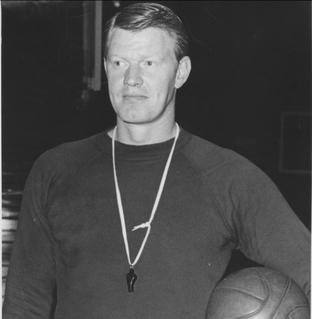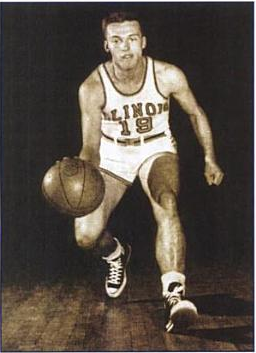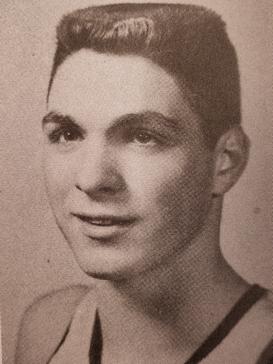Related Research Articles

John Graham Kerr, also known as Red Kerr, was an American basketball player, coach, executive and broadcaster who devoted six decades to the sport at all levels. The affable 6'9", 230-pound center starred for the University of Illinois (1951–1954) before he became a three-time All-Star and one-time league champion in the NBA (1954–66), primarily as a member of the Syracuse Nationals.

Thomas Dwight "Dike" Eddleman was an American athlete who was generally considered the greatest athlete in the history of athletics at the University of Illinois. Eddleman participated on the university's basketball, track and field, and football teams between the years of 1942 and 1949. Eddleman earned a combined 11 varsity letters in his career at the university, during which he also became a member of the Sigma Chi fraternity. Eddleman was born in Centralia, Illinois, and attended Centralia High School. On October 24, 2008, Eddleman was named a Distinguished Alumni of Centralia High school. He, along with five others, including James Brady, were the first to be named Distinguished Alumni. His wife, Teddy Eddleman, accepted his award.

Luther Dale Head is an American former professional basketball player.

Bruce Brett Weber is a former men's basketball head coach at Kansas State University. Prior to his tenure at Kansas State, Weber was the head coach at Southern Illinois University and the University of Illinois.

The Illinois Fighting Illini men's basketball team is an NCAA Division I college basketball team competing in the Big Ten Conference, that represent the University of Illinois Urbana-Champaign. Home games are played at the State Farm Center, located on the University of Illinois Urbana-Champaign's campus in Champaign. Illinois has one pre-tournament national championship and one non-NCAA tournament national championship in 1915 and 1943, awarded by the Premo-Porretta Power Poll. Illinois has appeared in the NCAA Division I men's basketball tournament 34 times, and has competed in 5 Final Fours, 10 Elite Eights, and has won 18 Big Ten regular season championships, and 4 Big Ten Tournament Championships.

Don J. Sunderlage was an American basketball player.
Duane W. "Skip" Thoren is an American former professional basketball player. At a height of 6 ft 10 in tall, he played at the center position.

The 2007–08 Illinois Fighting Illini men's basketball team represented University of Illinois at Urbana–Champaign in the 2007–08 NCAA Division I men's basketball season. This was head coach Bruce Weber's fifth season at Illinois. The team finished with 5–13 conference and 16–19 overall records. A runner-up finish in the Big Ten tournament, and the play of freshman guard Demetri McCamey highlighted the season. Shaun Pruitt was the lone all-Big-Ten honoree; he was named to the all-Big-Ten third team by the press.
Jenna Smith is an American former professional basketball center. She was drafted in the second round of the 2010 WNBA draft by the Washington Mystics, having previously played college basketball for the University of Illinois Fighting Illini where she earned First team All-Big Ten honors in 2008, 2009 and 2010. In 2016, she was named assistant coach of the Indiana State Sycamores women's basketball team.
Lowell Hamilton is an American former basketball player.

Bertil William Erickson was an NCAA All-American basketball player at the University of Illinois during a career that spanned from 1947 to 1950, and then a player in the National Professional Basketball League for the Saint Paul Lights.

James A. Bredar was an NCAA All-American basketball player at the University of Illinois during a career that spanned from 1949 to 1953, and then was drafted by the Ft. Wayne Pistons of the National Basketball Association in the 1953 draft
James C. Dawson is an American former professional basketball point guard who played one season in the American Basketball Association (ABA) as a member of the Indiana Pacers during the 1967–68 season. He attended University of Illinois at Urbana–Champaign where he was drafted by the Chicago Bulls during the 16th round of the 1967 NBA draft, but he did not play for them.

Bradley Cole Underwood is the current head coach for the Illinois Fighting Illini men's basketball team. Previously, he served as head coach at Oklahoma State, Stephen F. Austin, Dodge City Community College, and Daytona Beach Community College and assistant coach at Western Illinois, Kansas State, and South Carolina.
Cory Bradford is an American professional basketball player for Zhuhai Wolf Warriors. Bradford, a dominant high school guard, led Memphis's Raleigh-Egypt High School to a 1997 District 2A Championship while averaging 24 points, seven rebounds and six assists per game in his senior season. Bradford, an all-state, all-conference selection, was listed as the 72nd best high school prospect in 1997. He also averaged 22 points and nearly eight rebounds per game as a junior.

Trent Frazier is an American professional basketball player for Zenit and the VTB United League. He played college basketball for Illinois.

John M. Wessels was an American college basketball standout for Illinois in the late 1950s and early 1960s. A center, Wessels averaged 13.4 points and 8.7 rebounds per game in his three years of varsity basketball for the Fighting Illini, earning a varsity letter each year. Graduating from Rockford West High School, Wessels led the Warriors to the IHSA state championship during consecutive seasons in 1955 and 1956.

Clive Allen Follmer was an All-Big Ten Conference basketball player at the University of Illinois during a career that spanned from 1950 to 1953, followed by a two year stint in the Chicago White Sox Minor League affiliate, Topeka Owls and the Waterloo White Hawks.

The 2020–21 Illinois Fighting Illini men's basketball team represented the University of Illinois in the 2020–21 NCAA Division I men's basketball season. Led by fourth-year head coach Brad Underwood, the Illini played their home games at the State Farm Center in Champaign, Illinois as members of the Big Ten Conference. They finished the season 24–7, 16–4 in Big Ten play to finish in second place. They defeated Rutgers, Iowa, and Ohio State to win the Big Ten tournament and receive the conference's automatic bid to the NCAA tournament. As the No. 1 seed in the Midwest region, they defeated Drexel in the First Round before being upset by No. 8-seeded Loyola–Chicago in the Second Round.

Terrence Edward Shannon Jr. is an American professional basketball player for the Minnesota Timberwolves of the National Basketball Association (NBA). He played college basketball for the Texas Tech Red Raiders and the Illinois Fighting Illini.
References
- ↑ "Cosell Still Has His Way With Words". Los Angeles Times . April 18, 1986. Retrieved March 28, 2019.
- ↑ Myslenski, Skip; Kay, Linda (March 5, 1986). "News, notes and nonsense". Chicago Tribune . p. C2.
- ↑ "Parade All-American First Team Awards – RealGM". basketball.realgm.com.
- ↑ 2014 McDonald's All-American Program
- ↑ "Basketball.RealGM.com".
- ↑ SUPINIE, JOHN. "Winters cannot forget '84 NCAA loss to Kentucky". The State Journal-Register.
- ↑ Fighting Illini Basketball: A Hardwood History By News-Gazette, Sports Publishing LLC ISBN 1-58261-356-7
- 1 2 "Tate: Winters started resurgence". www.news-gazette.com. 7 January 2009.
- ↑ "Illini MBB Record Book pg. 129" (PDF). Archived from the original (PDF) on 2022-08-24. Retrieved 2019-03-20.
- ↑ A Century of Orange and Blue: Celebrating 100 Years of Fighting Illini Basketball By Loren Tate, Jared Gelfond pgs.268–270 ISBN 1-58261-793-7
- ↑ "Price Is Right; Georgia Tech Beats Illinois". Los Angeles Times . March 22, 1985. Retrieved March 3, 2019.
- 1 2 Tate, Loren (January 7, 2009). "Winters started resurgence". The News-Gazette. Retrieved August 27, 2019.
- ↑ Helfgot, Mike (February 9, 2011). "Former Illini Efrem Winters, Bruce Douglas still tight after meeting at McDonald's All-American Game 29 years ago". Chicago Tribune. Retrieved August 27, 2019.
Before the Douglas-to-Winters alley-oop became a staple of the Illini's mid-1980s resurgence...
- ↑ "Olympic Basketball Tryout Invitees". The Dallas Morning News . April 19, 1984. p. 14B.
- ↑ Horn, Barry (April 22, 1984). "4 from SWC make cut for U.S. basketball team; Those Who Made It". The Dallas Morning News . p. 10B.
- ↑ Consulting, Fine Line Websites & IT; Review, The Draft (14 August 2008). "Efrem Winters". The Draft Review.
- ↑ IBCA Hall of Fame
- ↑ "FightingIllini.com" (PDF). Archived from the original (PDF) on 2022-08-24. Retrieved 2019-03-20.
- ↑ "Efrem Winters College Stats". College Basketball at Sports-Reference.com.